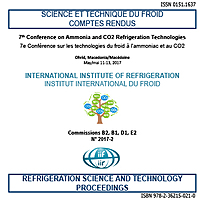
Document IIF
Analyses thermodynamiques du fonctionnement périodique d’unités frigorifiques à absorption à ammoniac-eau dans des systèmes de production d’eau atmosphérique.
Thermodynamic analysis of periodic operation ammonia-water absorption refrigeration units in atmospheric water generation systems.
Résumé
The usage of heat absorption water-ammonia refrigeration units in atmospheric water generation sys-tems is considered. A basic design of periodic operation AWRU is described. A method for thermodynamic calculations and analysis of AWRU PO cycles and modes of operation is presented. Specific refrigerating capacity depending on the composition of water-ammonia solution, the temperature of the heating source, the ambient temperature of the environment is calculated. It is shown that increasing the temperature of the heating source from 65°C to 95°C leads to minimum temperature in the cooling zone decreasing from 7°C to -17°C. Low-temperature ambient air at 25°C enables attaining the maximum value of refrigerating capacity of AWRU PO by increasing the proportion of ammonia in the initial composition from 0.3 to 0.5, and this enables lowering of the heating temperature from 95°C to 65°C.
Documents disponibles
Format PDF
Pages : 7
Disponible
Prix public
20 €
Prix membre*
Gratuit
* meilleur tarif applicable selon le type d'adhésion (voir le détail des avantages des adhésions individuelles et collectives)
Détails
- Titre original : Thermodynamic analysis of periodic operation ammonia-water absorption refrigeration units in atmospheric water generation systems.
- Identifiant de la fiche : 30021798
- Langues : Anglais
- Source : 7th Conference on Ammonia and CO2 Refrigeration Technology. Proceedings: Ohrid, North Macedonia, May 11-13, 2017.
- Date d'édition : 11/05/2017
- DOI : http://dx.doi.org/10.18462/iir.nh3-co2.2017.0043
- Document disponible en consultation à la bibliothèque du siège de l'IIF uniquement.
Liens
Voir d'autres communications du même compte rendu (42)
Voir le compte rendu de la conférence
Indexation
- Thèmes : Systèmes à absorption et adsorption
- Mots-clés : Thermodynamique; Système frigorifique; Calcul; Ammoniac-eau; Système à absorption
-
THE THERMODYNAMIC PROPERTIES OF AMMONIA-WATER M...
- Auteurs : JENNINGS B. H.
- Date : 1981
- Langues : Anglais
Voir la fiche
-
Wybrane zagadnienia z techniki chlodniczej i kl...
- Auteurs : BUTRYMOWICZ D.
- Date : 2004
- Langues : Polonais
- Source : Technika Chlodnicza i Klimatyzacyjna - vol. 11 - n. 2
Voir la fiche
-
Effect of ammonia-water mixture database on cyc...
- Auteurs : ZAWACKI T. S.
- Date : 24/03/1999
- Langues : Anglais
- Source : Proceedings of the International Sorption Heat Pump Conference.
Voir la fiche
-
Wizualizacja i obliczanie obiegu absorpcyjnego ...
- Auteurs : EICHLER J., KASPERSKI J.
- Date : 10/2007
- Langues : Polonais
- Source : Chlodnictwo - vol. 42 - n. 10
Voir la fiche
-
EXERGY ANALYSIS OF AN AQUA-AMMONIA ABSORPTION R...
- Auteurs : ATAER O. E.
- Date : 24/09/1990
- Langues : Anglais
- Formats : PDF
Voir la fiche
